The effects of welfare eligibility and abortion restrictions on the pregnancy decisions of young women
Bạn đang xem bản rút gọn của tài liệu. Xem và tải ngay bản đầy đủ của tài liệu tại đây (1.59 MB, 272 trang )
The Pennsylvania State University
The Graduate School
College of Health and Human Development
THE EFFECTS OF WELFARE ELIGIBILITY AND ABORTION RESTRICTIONS
ON THE PREGNANCY DECISIONS OF YOUNG WOMEN
A Dissertation in
Human Development and Family Studies and Demography
by
Samuel W. Sturgeon
2009 Samuel W. Sturgeon
Submitted in Partial Fulfillment
of the Requirements
for the Degree of
Doctor of Philosophy
May 2009
UMI Number: 3374547
INFORMATION TO USERS
The quality of this reproduction is dependent upon the quality of the copy
submitted. Broken or indistinct print, colored or poor quality illustrations and
photographs, print bleed-through, substandard margins, and improper
alignment can adversely affect reproduction.
In the unlikely event that the author did not send a complete manuscript
and there are missing pages, these will be noted. Also, if unauthorized
copyright material had to be removed, a note will indicate the deletion.
______________________________________________________________
UMI Microform 3374547
Copyright 2009 by ProQuest LLC
All rights reserved. This microform edition is protected against
unauthorized copying under Title 17, United States Code.
_______________________________________________________________
ProQuest LLC
789 East Eisenhower Parkway
P.O. Box 1346
Ann Arbor, MI 48106-1346
The dissertation of Samuel W. Sturgeon was reviewed and approved* by the following:
David J. Eggeben
Associate Professor of Human Development and Family Studies, Sociology, and
Demography
Dissertation Adviser
Co-Chair of Committee
Gordon F. DeJong
Distinguished Professor of Sociology and Demography
Co-Chair of Committee
Micheal J. Rovine
Professor of Human Development
Kathryn Hynes
Assistant Professor of Human Development and Family Studies and Demography
Deborah Graefe
Research Associate, the Population Research Institute
Douglas M. Teti
Professor of Human Development
Professor-in-Charge of HDFS Graduate Program
*Signatures are on file in the Graduate School.
ABSTRACT
Using data on state abortion restrictions, state family formation related welfare policy stringency,
and the fertility and pregnancy histories of women from the National Longitudinal Survey of
Youth 1997 Cohort (NLSY97), this project examined whether or not state welfare and abortion
policies between 1997 and 2004 are related to one another, and whether these polices affect the
decisions of young mothers regarding pregnancy and pregnancy resolution. One of the major
goals of the 1996 welfare reforms was to reduce non-marital fertility as a means of reducing
welfare dependence. However, some groups feared that efforts to limit non-marital fertility
would lead to an increase in abortion. Moreover, economic theory suggests that strict welfare and
abortion policies may be working at cross purposes with one another. In general, I find that
states with more stringent abortion policies tended to adopt more stringent family formation
related welfare polices; however, stringent state welfare and abortion policies were only mildly
correlated over this time period (r = 0.11). Moreover, I find some evidence to suggest that state
policy stringency summary scores may be a better means of examining the effects of state policy
stringency than estimating the effects of specific individual policies. In general, state welfare
and abortion policies did not appear to affect either the likelihood of pregnancy among all of the
women in the sample, or the likelihood that the pregnant women in the sample would elect to
have an abortion over a live birth. In addition, there was little evidence to suggest that stringent
state welfare and abortion polices are working at cross purposes when it comes to women’s
pregnancy decisions. Overall, the characteristics of the survey sample (e.g. too small, too
homogeneous, not representative at the state level, etc.) made it difficult to isolate the effects of
state policies on the respondents’ pregnancy decisions net of other unmeasured state
characteristics, thus making it impossible to assess the effects of these policies with this data.
iii
TABLE OF CONTENTS
List of Tables ............................................................................................................................... vi
List of Figures............................................................................................................................... ix
Acknowledgements ...................................................................................................................... xi
Chapter One: Introduction .............................................................................................................1
Chapter Two: Theoretical Background........................................................................................10
Rational Choice Theory .....................................................................................................10
Ecological Models of Human Development......................................................................17
Measuring State Welfare and Abortion Policy Stringency................................................21
General Theoretical Framework and Conclusions.............................................................25
Chapter Three: Literature Review ...............................................................................................31
A Brief History of PRWORA ............................................................................................31
State Characteristics Associated with Welfare and Abortion Policy Stringency ..............34
Trends in Welfare Use, Non-marital Births, Teen Pregnancy and Abortion.....................36
The Link between Non-marital Childbearing and Welfare Dependence...........................39
Effects of Welfare and Abortion Policies on Pregnancy and Abortion .............................42
Personal and Family Background Factors Associated With Pregnancy and Abortion......50
Conclusion .........................................................................................................................53
Chapter Four: State Welfare and Abortion Policies from January 1997 to December 2004 ......60
State Policy Data Description and Coding.........................................................................60
State Policy Cross Correlations .........................................................................................72
Conclusion .........................................................................................................................77
iv
Chapter Five: NLSY97 Data Description and Variable Coding................................................111
Data Collection and Sample Description........................................................................113
Dataset Creation..............................................................................................................115
Variable Coding ..............................................................................................................118
Chapter Six: Predictors of Pregnancy ........................................................................................130
Research Questions and Hypotheses ...............................................................................130
Analysis Strategy .............................................................................................................135
Results..............................................................................................................................141
Discussion ........................................................................................................................153
Chapter Seven: Predictors of Pregnancy Resolution .................................................................167
Research Questions and Hypotheses ...............................................................................167
Analysis Strategy .............................................................................................................171
Results..............................................................................................................................176
Discussion ........................................................................................................................193
Chapter Eight: Conclusion.........................................................................................................210
Summary of Findings.......................................................................................................210
Theoretical and Methodological Concerns ......................................................................215
Directions for Future Research ........................................................................................223
Final Thoughts .................................................................................................................226
Appendix: Coding Pregnancy Histories and Independent Variables..........................................230
Bibliography ...............................................................................................................................244
v
LIST OF TABLES
Table 2.1. The Hypothesized Main Effects of Welfare and Abortion Policy on Pregnancy,
Abortion and Live Births at the Individual and State Level ..............................................29
Table 2.2. The Hypothesized Interaction Effects of Welfare and Abortion Policy on Pregnancy,
Abortion and Live Births at the Individual and State Level ..............................................30
Table 4.1. States with a Family Cap Policy January 1997 – December 2004 ..............................84
Table 4.2. States Where Pregnant Women Were Not Eligible for Welfare Benefits January 1997
December 2004 ..................................................................................................................85
Table 4.3. States with Welfare Benefits Levels below the National Median 1997-2004 .............86
Table 4.4. Determinants of State Welfare Policy Cut-off Scores .................................................87
Table 4.5. States with Limited Public Funding for Abortion January 1997 – December 2004....88
Table 4.6. States with Parental Involvement Laws January 1997 – December 2004 ...................89
Table 4.7. States with Informed Consent Laws January 1997 – December 2004.........................90
Table 4.8. States with Waiting Period Laws January 1997 – December 2004 .............................91
Table 4.9. Determinants of State Abortion Policy Cut-off Scores................................................92
Table 4.10. Correlations between State Welfare Policies January 1997-December 2004............93
Table 4.11. Correlations between State Abortion Policies January 1997-December 2004 ..........94
Table 4.12. Correlations between State Welfare and Abortion Policies January 1997- December
2004....................................................................................................................................95
Table 4.13. Typologies of State Welfare and Abortion Policies January 1997-December
2004....................................................................................................................................96
Table 4.14. Dichotomous Typologies of State Welfare and Abortion Policy January 1997December 2004 ..................................................................................................................97
vi
Table 4.15. Marginal Probabilities of Lenient and Stringent State Welfare and Abortion Policies
January 1997-December 2004 ...........................................................................................98
Table 5.1. NLSY97 Interview Schedule and Number of Respondents Interviewed in Waves
1-8 ....................................................................................................................................127
Table 5.2. Number of Interviews Completed by the NLSY97 Female Respondents .................128
Table 5.3. Demographic Characteristics of the Women in the NSLY97 (N = 4,385) ................129
Table 6.1. Correlations between Measures of Time (N = 375,884)............................................159
Table 6.2. Odds Ratios for the Likelihood of Pregnancy: Individual and Family
Characteristics..................................................................................................................160
Table 6.3. Odds Ratios for the Likelihood of Pregnancy: Trimmed Covariates Model .............161
Table 6.4. Odds Ratios for the Likelihood of Pregnancy: Individual State Policy Variables.....162
Table 6.5. Odds Ratios for the Likelihood of Pregnancy: Tests of Specific Policy Hypotheses163
Table 6.6. Odds Ratios for the Likelihood of Pregnancy: Individual State Policy Summary
Scores...............................................................................................................................164
Table 6.7. Odds Ratios for the Likelihood of Pregnancy: State Policy Typologies ...................165
Table 6.8. Results of Hypotheses on the Effects of State Welfare and Abortion Policies on the
Likelihood of Pregnancy..................................................................................................166
Table 7.1. Correlations between Measures of Time (N = 3,181)................................................200
Table 7.2. Univariate Odds Ratios for the Likelihood of Abortion vs. Live Birth and
Miscarriage/ Stillbirth vs. Live Birth ...............................................................................201
Table 7.3. Multivariate Odds Ratios for the Likelihood of Abortion vs. Live Birth and
Miscarriage/Stillbirth vs. Live Birth ................................................................................202
vii
Table 7.4. Odds Ratios for the Likelihood of Abortion vs. Live Birth and Miscarriage/Stillbirth
vs. Live Birth: Trimmed Covariates Model.....................................................................203
Table 7.5. Odds Ratios for the Likelihood of Abortion vs. Live birth: Individual State Policy
Variables ..........................................................................................................................204
Table 7.6. Odds Ratios for the Likelihood of Abortion vs. Live Birth: Tests of Specific
Hypotheses.......................................................................................................................205
Table 7.7. Odds Ratios for the Likelihood of Abortion vs. Live Birth: Individual State Policy
Summary Scores ..............................................................................................................206
Table 7.8. Odds Ratios for the Likelihood of Abortion vs. Live Birth: State Policy
Typologies........................................................................................................................207
Table 7.9. Results of Hypotheses on the Effects of State Welfare and Abortion Policies on the
Likelihood of Abortion ....................................................................................................208
Table 7.10. Correlations between State Abortion Outcomes and State Welfare Policy Typologies
1997-2004 ........................................................................................................................209
Table 8.1. The Hypothesized and Observed Effects of Welfare and Abortion Policy on
Pregnancy and Abortion at the Individual Level .............................................................228
Table 8.2. Lives Births per 1,000 Women by 5-Year Age Group, United States, 2004.............229
Table A.1. Coding of the Race Variables....................................................................................239
Table A.2. Non-weighted Variable Means and Distributions.....................................................240
viii
LIST OF FIGURES
Figure 2.1. The Pregnancy Decision Tree for a Generalized Rational Choice Model .................27
Figure 2.2. General Theoretical Framework for Examining the Effects of Welfare Eligibility and
Abortion Restrictions on the Pregnancy Decisions of Young Women..............................28
Figure 3.1. Average Number of Welfare Recipients (in millions): USA 1960-2004 ...................54
Figure 3.2. Percent of Births to Unmarried Mothers: USA 1950-2004........................................54
Figure 3.3. Percent of Births to Unmarried Mothers by Age of Mother: USA 1950-2004 ..........56
Figure 3.4. Pregnancies per 1,000 Women Ages 15-19: USA 1976-2004 ...................................57
Figure 3.5. Abortions per 1,000 Live Births: USA 1970-2004.....................................................58
Figure 3.6. Abortions per 1,000 Live Births by Age Group: USA 2004 ......................................59
Figure 4.1. State Family Cap Policies in January 1997 and December 2004 ...............................99
Figure 4.2. State Policies Regarding the Welfare Eligibility of Pregnant Women in January 1997
and December 2004 .........................................................................................................100
Figure 4.3. State Welfare Benefit Levels in January 1997 and December 2004 ........................101
Figure 4.4. State Welfare Policy Stringency in 1997 and December 2004 ................................102
Figure 4.5. State Policies Regarding the Public Funding of Abortion in January 1997 and
December 2004 ................................................................................................................103
Figure 4.6. State Parental Consent and Parental Involvement Policies in January 1997 and
December 2004 ................................................................................................................104
Figure 4.7. State Policies Regarding Informed Consent before an Abortion in January 1997 and
December 2004 ................................................................................................................105
Figure 4.8. State Policies Regarding Waiting Periods Before an Abortion in January 1997 and
December 2004 ................................................................................................................106
ix
Figure 4.9. State Abortion Policy Stringency in January 1997 and December 2004 .................107
Figure 4.10. Simulated Contingency Table and Correlation between Two State Policies .........108
Figure 4.11. State Welfare and Abortion Policy in January 1997 ..............................................109
Figure 4.12 State Welfare and Abortion Policy in December 2004 ...........................................110
Figure A.1. Female NLSY97 Respondents Enrolled in School January 1997-December
2004..................................................................................................................................243
x
ACKNOWLEDGEMENTS
First, I would like to thank my wife for her constant love and patient support. I am
continually indebted to her for the many ways she brings beauty, peace, and joy into my life and
my work. I would also like to thank my two young daughters for their exuberant happiness and
the invigorating energy of their hugs and smiles. I also thank my mother and grandfather for
setting the example, inspiring this dream, and providing continued support.
I am grateful to Dave Eggebeen, my advisor, for his thoughtful training, guidance and
friendship. He is a craftsman of both research and student mentoring and has had a positive
influence on my life which extends far beyond scholarly pursuits. I thank him for helping me to
strike the right balance between personal and professional demands, desires, and opportunities.
I am also grateful to Gordon DeJong. Few people are as passionate or persistent about
demographic research and training as he is, and I am grateful for his kind and consistent
encouragement. I thank him for helping me see past my self-imposed limits, continually pushing
me to reach higher, and also granting me the opportunities to do so.
I would also like to thank the other members of my committee for their support and
assistance. Deb Graefe strives for excellence in everything that she theorizes, writes, analyzes—
or ever works on or pursues. I am grateful that she always demanded the same from me. Mike
Rovine is perhaps the most patient, accessible, and gifted instructor of research methodology. I
am grateful for his many consultations and the confidence he has instilled within me. Kathryn
Hynes is a very talented and accomplished young professor. As an aspiring young researcher
myself, I thank her for showing me through her example how to be a professional scholar.
I would also like to thank the faculty and staff in HDFS and at PRI for the many hours of
teaching, assisting, and training I received. In particular, I thank Rukmalie Jayakody for helping
me recognize early on that my interests lie in public policy and demography. Lastly, I thank the
Hintz Family, NICHD, and all the others whose generous funding made this all possible.
xi
CHAPTER ONE: Introduction
Deciding whether to get pregnant, and if pregnant how to resolve a pregnancy, can be
two very difficult and very personal decisions. However, in some instances state and federal
governments may have a vested interest in influencing these personal pregnancy decisions. State
family formation related welfare policies and state abortion policies are two examples of
government interventions aimed at shaping pregnancy decisions. Using data on state welfare and
abortion policy stringency and data on the fertility and pregnancy histories of women from the
National Longitudinal Survey of Youth, 1997 Cohort (NLSY97), this project examines whether
or not state welfare and abortion policies are related to one another, and whether these policies
affect the decisions of young mothers regarding pregnancy and pregnancy resolution.
One of the major goals of the 1996 Personal Responsibility and Work Opportunities
Reconciliation Act (PRWORA, Public Law 104-193) was to reduce non-marital fertility as a
means of reducing welfare dependence. This idea was based on a three key assumptions: 1) Outof-wedlock childbearing was a leading cause of welfare dependence; 2) The previous welfare
program made it economically possible for women to have children they otherwise could not
afford, including children born out of wedlock; and 3) Making welfare more difficult to obtain
would reduce the likelihood of non-marital births and thereby reduce long term welfare
dependence (Causes of Poverty, 1996; Haskins, 2006). In order to receive federal welfare funds,
each state was required to submit a state welfare plan outlining how they planned to “Establish
goals and take action to prevent and reduce the incidence of out-of-wedlock pregnancies, with
special emphasis on teenage pregnancies, and establish numerical goals for reducing the
illegitimacy ratio of the State” (Public Law 104-193 sec. 402 (a)(1)(A)(v)).
1
Many politicians and policy analysts agreed that the current welfare program provided
incentives for non-marital births and that lowering non-marital births was a worthy goal.
However, religious conservatives feared that a strict tightening of welfare eligibility and an
emphasis on reducing non-marital births would lead to a greater demand for abortion (Klerman,
1998; Haskins, 2006). As a compromise, the final version of the welfare reform bill granted
illegitimacy bonuses totaling $100 million each year to the five states that experienced the largest
drop in non-marital births without a subsequent increase in the state abortion rate.
In the original legislation the illegitimacy bonuses were to be granted to the states that
had experienced the greatest percentage decline in the absolute number of non-marital births
during the most recent two year period, relative to the previous two year period (Public Law 104193). However, states were disqualified if their abortion rate for the two year period was greater
than the state abortion rate for the 1995 fiscal year. Shortly after the bill’s passage, many of the
states that were experiencing rapid population growth asked that the criterion for the bonuses be
changed from a percentage drop in the absolute number of non-marital births to a decrease in the
illegitimacy ratio—the number of non-marital births divided by the number of total births. This
change was included in the Balanced Budget Act of 1997 (Public Law 105-33), and the first
bonuses were awarded in 1999.
States now had an economic incentive to reduce their non-marital birth ratio while not
increasing their abortion rate. Moreover, though states had to submit a plan for reducing teen
and non-marital births, there were few restrictions placed on how they might use welfare policies
to achieve their goals. States could reduce non-marital births by encouraging marriage or
drafting policies that discouraged non-marital pregnancies. The 1996 welfare reforms
encouraged state legislatures to be creative in their policy making and there is evidence of
2
significant state variation in welfare laws aimed at promoting traditional family forms and
reducing non-marital fertility (Graefe et al., 2006).
Many states tried to lower the non-marital birth ratio by promoting marriage. Because
the non-marital birth ratio is calculated as the number of non-marital births divided by the
number of total births, states could lower the non-marital birth ratio by increasing marriage rates
among unmarried expectant couples and other unmarried couples who were likely to have
children together. One advantage of policies dealing with marriage is that they have the potential
to lower a state’s non-martial birth ratio without having a negative impact on the state’s abortion
rate.
States could also compete for the illegitimacy bonuses by passing laws which created a
disincentive for having a child out of wedlock. Economic theory suggests that policies that raise
the cost of non-marital childbearing for poor women will lead to a decrease in non-marital births
(Murray, 1984). However, unlike marriage policies, raising the cost of childbearing for poor
woman is also likely to increase the odds that these women will elect to have an abortion
(Klerman, 1998). Therefore, in order to reduce non-marital births while not increasing the
abortion rate, states would also need to place restrictions on abortions. On the other hand, strict
abortion policies are theorized to lead to an increase in live births among pregnant women
(Levine & Staiger, 2002); leading some to argue that attempting to reduce female headship
through restrictions on welfare eligibility, while also placing greater restrictions on women’s
access to abortion, could be counterproductive as the two policies may work at cross-purposes
(Lichter, McLaughlin, & Ribar, 1998).
Generally, welfare policies aimed at reducing non-marital childbearing have had limited
effects. In a review of relevant research, Moffit (1992), and later Hoffman and Foster (2000),
3
conclude that the causal link between welfare policy and fertility decisions is consistent, yet not
very strong. Moreover, when examining the effects of specific welfare policies on non-martial
childbearing, the results are generally inconclusive (See Dyer & Fairlie, 2004; Horvath-Rose &
Peters, 2001; Jagannathan & Camasso, 2003; Joyce et al., 2004; Kearney, 2002; Sabia, 2008).
One reason for the generally mixed results may be that the effects of welfare policy are masked
by the countervailing effects of abortion policy, though very few studies have examined the
relationship between state welfare and abortion policy stringency.
Though research on the relationship between state abortion policies and family formation
related welfare policies is limited, there is a small body of circumstantial evidence which
suggests that the stringency of the two policies types may be related within states. For example,
Graefe et al. (2006) report that in the post welfare reform era states with stringent welfare
policies regarding family formation behaviors tended to be those with a high percentage of voters
self-identifying as members of the religious right, whereas more lenient states tended to have a
high percentage of voters self-identifying as ideologically liberal. On the other hand, Strickland
and Wicker (1992) find that states with a high proportion of residents that are religiously
conservative tend to have more restrictive abortion policies; while Medoff (2002) reports that
state membership in NARAL Pro-Choice America, is a strong predictor of more lenient abortion
policy. Moreover, Norrander and Wilcox (1999) report that states with traditionally conservative
stances on other social policies tend to pass restrictive abortion laws.
Given that both stringent welfare and stringent abortion policies tend to be favored by
states that are more ideologically conservative and lenient welfare and lenient abortion policies
tend to be favored by sates that are more ideologically liberal, there is reason to believe that state
abortion policies and welfare policies influencing family formation behaviors may be associated.
4
If the stringency of welfare policies and abortion policies within a state are related, then
economic theory would suggest that these policies may be working at cross purposes with regard
to women’s fertility decisions (Lichter et al., 1998). Moreover, if these policies are working at
cross purposes, this may explain why the hypothesized incentive effects of welfare have at best a
moderate influence on women’s pregnancy decisions.
In order to determine whether state welfare and abortion policies work at cross purposes,
one would first need to determine whether or not state family formation related welfare policy
stringency is related to state abortion policy stringency. Second, one would need to assess
whether state welfare policy stringency and state abortion policy stringency affect the likelihood
that women will get pregnant, and among those that are pregnant, the likelihood that they choose
abortion over a live birth. Though several researchers have examined the effects of welfare
reform policies on fertility and family formation behaviors, few have examined the effects of
PRWORA on the pregnancy resolution decisions of young mothers (i.e. whether they choose
abortion over a live birth). Moreover, though many have examined the effects of abortion
policies on pregnancy resolution decisions, few have accounted for the competing incentive
effects of welfare policies. Using data on state welfare and abortion policy stringency and data
on the fertility and pregnancy histories of women from the NLSY97 survey, this project
examines whether or not state welfare and abortion policies are related, and whether these
policies affect the decisions of young mothers regarding pregnancy and pregnancy resolution.
Utilizing Bronfenbrenner’s ecological model of human development (Bronfenbrenner, 1979) and
rational choice theories from the field of economics (Becker, 1991), this project aims to answer
the following questions:
5
1. Do states that adopt stringent family formation related welfare policies also tend to
adopt stringent abortion policies?
2. After accounting for personal, familial, and other contextual variables, do state
welfare and abortion policies in the era of welfare reform affect the likelihood of
pregnancy among a sample of young women?
3. After accounting for personal, familial, and other contextual variables, do state
welfare and abortion policies in the era of welfare reform affect how pregnant women
choose to resolve a pregnancy, either though live birth or abortion?
This project improves upon previous research in this area in several ways. First, this
projects attempts to measure the relationship between state abortion policy stringency and family
formation related welfare policy stringency during the era of welfare reform. The project also
examines the competing effects of state abortion policies and state welfare policies on the
pregnancy decisions of young women. Moreover, much of the previous research on state
policies has compared aggregate state rates (e.g. birthrates or abortion rates). Though this
approach is useful for testing the overall effectiveness of state policies, it does not allow
researchers to examine the individual processes involved in pregnancy decisions. This project
utilizes both state level policy data and individual longitudinal data, thus allowing for an
examination of multiple levels of influence. Moreover, unlike previous research, which was
often limited to either first pregnancies or second and higher order pregnancies, the longitudinal
nature of the data allows for a test of the effects of state policy on both first and higher order
pregnancies. Perhaps most importantly, unlike previous studies that examined cross-state
variation in AFDC benefits, this study utilizes data from young women whose fertility histories
6
occurred under TANF, the new welfare program implemented under the 1996 welfare reform
legislation.
The remaining chapters provide a complete description of the research project. In
Chapter Two, I discuss the theoretical framework behind the specific research questions and
hypotheses. Most of the research questions and hypothesized relationships are derived from
rational choice theory from the field of economics (Becker, 1991) and Bronfenbrenner’s
ecological model of human development (Bronfenbrenner, 1979). Chapter Two also discusses
the theoretical rationale behind alternative methods of coding and estimating the effects of state
policy stringency, including the advantages and disadvantages of examining individual state
policies and state policy stringency summary scores. I also discuss a general theoretical
framework for examining the effects of welfare eligibility and abortion restrictions on the
pregnancy decisions of young women
Chapter Three provides a comprehensive review of relevant research literature. In the
review, I cover trends in non-marital childbearing, abortion, and welfare participation, and
factors associated with state welfare and abortion policy stringency. I also discuss the link
between non-marital childbearing and welfare dependence. In addition, I provide a summary of
the research on factors associated with young women’s pregnancy and pregnancy resolution
decisions, with a special emphasis on the effects of state welfare and abortion policies.
Chapter Four provides an in depth examination of state welfare and abortion policies
from January 1997 to December 2004. In this chapter, I describe how the data on state policies
was collected and coded and I provide a detailed explanation of the creation of a series of state
abortion and welfare policy stringency summary scores. In addition, I provide a detailed
description of the prevalence of specific state policies and provide a brief summary of the
7
welfare and abortion policies either in place or adopted by each state between January 1997 and
December 2004. I also examine the correlation over time between individual state welfare and
abortion policies, as well as the relationship between state welfare and abortion policy stringency
summary scores from January 1997 to December 2004.
In Chapter Five, I provide a detailed description of the NLSY97 sample, the methods
used in creating two separate datasets for later analyses, and the coding of the dependent and
independent variables. In order to examine factors associated with the likelihood of pregnancy,
and the likelihood of abortion among those that were pregnant, I utilize data from female
respondents who participated in any of the first eight waves of the NLSY97. First I had to
generate the complete pregnancy histories for each of the women in the sample. I also had to
calculate a series of time varying covariates and merge the data with the NLSY97 restricted geo
code file in order to match respondents with the appropriate state policies. Because much of the
information in this chapter is rather technical in nature, the more specific aspects of dataset
creation and variable coding are included in an accompanying appendix. Chapter Five and the
accompanying appendix outline all of the decision rules used for creating the appropriate
datasets and for coding all of the independent and dependent variables. The information
provided in these two sources should be sufficient for anyone wishing to reproduce the data used
in the analyses, or to evaluate the assumptions and decision rules made throughout the research
project.
Chapter Six focuses on factors associated with the likelihood of pregnancy among the
women in the sample. First, I discuss the analysis strategy and propose several hypotheses
regarding the effects of personal, familial and contextual factors on the risk of pregnancy. Next,
using a discrete time hazard model with time varying covariates, I estimate the effects of state
8
welfare and abortion policies on the odds that a woman will get pregnant within a given month,
after controlling for personal and family background characteristics. After presenting the results
of the analysis, I discuss the significance of the findings.
Chapter Seven is similar to Chapter Six, except that the analysis is limited to pregnant
woman and focuses on factors associated with the decision to resolve a pregnancy through live
birth or induced abortion. After outlining the analysis strategy and the proposed hypotheses, I
use a multinomial logistic regression model to estimate the effects of state welfare and abortion
policies on the odds that a woman will chose abortion over live birth, after controlling for
personal, family background, and other contextual variables. After presenting the results of the
analysis, I discuss the significance of the findings.
In the final chapter, I provide a summary review of the research findings and an overall
assessment of the current research project. In this chapter I discuss the interrelationships
between the findings from several chapters and the significance of this research as it relates to
other public policy issues. I also asses the limitations of the current research project, including
internal threats to validity, and discuss directions for future research in this field.
9
CHAPTER TWO: Theoretical Background
This research project presupposes that state welfare and abortion policies influence the
individual pregnancy decisions of young women. Whether or not state policies have an actual
impact is an empirical question which I hope to answer in subsequent chapters. In the meantime,
based on rational choice models and ecological theories of development, this chapter provides an
outline of the theoretical rationale for hypothesizing a policy impact. In addition, in this chapter
I discuss the advantages and disadvantages of using individual state policies and state policy
stringency summary scores in order to identify the magnitude of the hypothesized effects. I also
discuss theoretical reasons for hypothesizing that state welfare and abortion policy stringency
may be related, and provide an overarching theoretical framework for the analysis.
Rational Choice Theory
Rational choice is a theoretical perspective based on two basic assumptions about human
behavior, which provides the fundamental rationale for public policy making. The first
assumption is methodological individualism, or the idea that macro-level events or observations
can be explained by individual-level behaviors (Wrong, 1997). The second assumption of
rational choice theory is rationality, or the notion that, when faced with a decision, actors select
one of several options based on what is most likely to maximize their individual utility—the
perceived benefits of an action based on their individual preferences (Becker, 1991). One of the
fundamental assumptions of welfare policy is that changes in policy will affect the individual
decisions of members of the target population, thus leading to a greater good at the population
10
level (Wrong, 1997). In other words, the very act of welfare policy making assumes
methodological individualism and rationality of individual choice.
Many of the 1996 welfare reform initiatives were based on the principles of
methodological individualism and rationality of individual choice (Kaestner, 1998). As a result,
rational choice models provide a useful perspective for evaluating the effectiveness of state
welfare and abortion policies. For example, the 1996 welfare legislation granted bonuses to
states with the largest reductions in aggregate non-marital birth ratios. In this case, the
assumption of methodological individualism implied that changes in population level nonmarital birth ratios were a result of the cumulative decisions and behaviors of the individuals in
the population. Therefore, one way to examine the effects of state policies on population
measures of fertility would be to examine the effects of these policies on the individual fertility
decisions of individual members of the population. In addition, in the case of the 1996 welfare
reforms it was believed that lowering the incentives and raising the disincentives associated with
non-marital childbearing would lead many women to decide against having children out-ofwedlock (Haskins, 2006). In other words, it was believed that potential welfare participants were
rational actors whose pregnancy decisions could be shaped by altering the costs of pregnancy
and childbearing. For these reasons, rational choice provides a useful theoretical framework for
analyzing the effects of state welfare and abortion policy stringency on women’s pregnancy
decisions.
Figure 2.1 portrays the basic decision tree relating pregnancy and pregnancy resolution
decisions. In this model, a woman must first decide whether or not to get pregnant, and once
pregnant, she must decide how to resolve the pregnancy. Rational choice theory assumes that,
when faced with a decision like pregnancy, actors select the option that maximizes their
11
individual utility (Becker, 1991). When evaluating which of several options might bring the most
individual benefit, actors may evaluate their current resources, information about available
options and programs, and the perceived impact the decisions will have on the actors’ desired
immediate and future ambitions. Moreover, Levine (2002) argues that this information can
change at various times during the pregnancy decision process. For example, a young mother
may fully intend to have a child and therefore choose to get pregnant; however, upon hearing
that her fetus has a genetic abnormality, she may opt to terminate the intended pregnancy.
According to Becker (1991), pregnancy and fertility can be modeled from a marginalcost and marginal-benefit framework. This suggests that pregnancy and childbirth are associated
with a trade-off between the costs and the benefits of the action, and that a woman will only elect
to get pregnant or to have a child when the benefits of doing so are greater than the perceived
costs. Therefore, the likelihood of pregnancy or childbirth can be altered by either adjusting the
costs, the benefits, or both. Actions or events which raise the costs or lower the benefits of
pregnancy and childbearing will reduce the likelihood of pregnancy and childbearing; whereas
actions or events which lower the costs or raise the benefits of pregnancy and childbearing will
increase the likelihood of pregnancy and childbearing.
Table 2.1 portrays the main effects of state welfare and abortion policies on pregnancy,
abortion, and childbirth at the individual and state level. Following rational choice theory,
effects at the state level are assumed to represent the cumulative effects of many individual
choices. Economic theory suggests that providing a cash benefit to poor single women with
children lowers the cost of child bearing, and thereby encourages women to have children
outside of marriage that they would not normally consider without the guarantee of public
assistance (Murray, 1984). A lenient state welfare policy is likely to provide a sense of security
12
for poor single women, thus fewer women will take steps to avoid pregnancy thereby increasing
their likelihood of getting pregnant. Among those women that are pregnant, economic theory
suggests that a lenient welfare system will increase their odds of choosing motherhood over
abortion. At the state level, a generous welfare policy will raise the non-marital pregnancy rate.
However, because women are more likely to choose motherhood over abortion, the expected
overall effect would be an increase in the non-marital birthrate with very little change in the
overall abortion rate. The exact opposite would be expected of a stringent state welfare policy
(see Table 2.1).
State abortion policies may also influence the pregnancy decisions of young women. In
many regards, abortion functions economically as “insurance” (Levine & Staiger, 2002). When
abortion is difficult to obtain, women tend to reduce their risk of pregnancy (e.g. using a more
reliable form of contraception). As outlined in Table 2.1, when abortion policies are restrictive
women are less likely to get pregnant. Moreover, among those who are pregnant, when the cost
of abortion is high, they are more likely to choose motherhood over abortion. At the state level,
when restrictive abortion policies are in place, one would expect to observe a decrease in both
the pregnancy rate and the abortion rate. However, the overall non-marital fertility rate is likely
to remain the same, as the decrease in pregnancies is likely to be offset by the increase in the
proportion of pregnant women choosing motherhood. The opposite is true for a lenient state
abortion policy, with one exception. When abortion is readily available, women are more likely
to get pregnant and to choose abortion. However, many of the women that conceived only
because abortion was available actually opt for motherhood once pregnant. Therefore, lenient
state abortion policy tends to increase the overall pregnancy, abortion, and non-marital birth rates
(Levine & Staiger, 2002).
13
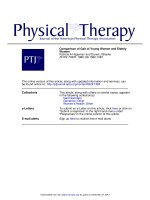



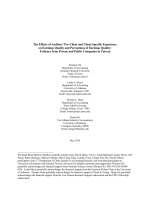
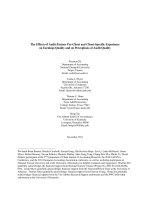
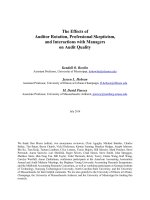
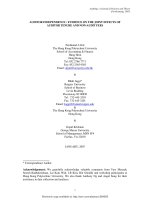
![daniels and booker - 2011 - the effects of audit firm rotation on perceived auditor independence and audit quality [mafr]](https://media.store123doc.com/images/document/2015_01/06/medium_sds1420548148.jpg)
![khasharmeh and said - 2014 - effects of mandatory audit firm rotation upon quality of audit - the perception of audit firms-evidence from bahrain [marf]](https://media.store123doc.com/images/document/2015_01/06/medium_3d4BCTv20p.jpg)